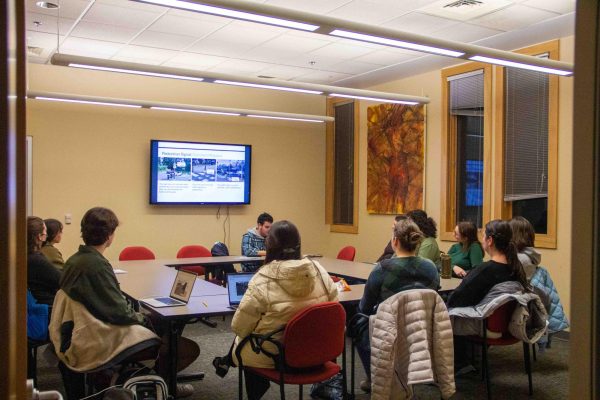
Last semester, the word “ramp” was commonplace around campus, sprawled in colorful chalk on steps and next to cracks and ramps (or the lack thereof) as students highlighted the inaccessibility of many spaces that were previously portrayed as accessible. This raised concerns for many and in response, the Community Service Interest House partnered with the Career and Community Engagement Center (CCEC) to bring Project Sidewalk to campus.
Project Sidewalk is a volunteer project that aims to increase accessibility by assessing infrastructure and providing data to local planning boards and groups, such as the Blue Mountain Mobility Action Group.
Sophomore Caty Taylor participated in the project, and explained that its versatility made it easy to engage in the community beyond Whitman.
“Project Sidewalk is one of the many programs on campus that allows students to get outside the Whitman bubble and to get close to the Walla Walla community, and not just take things from the community, but turn them back in a positive way,” Taylor said.
The project was designed and operated through the Makeability lab at the University of Washington, and its website uses street imaging to to assess the accessibility of different features of walkways and ramps through a virtual tour of the area. If something is not accessible, volunteers can flag that specific location on the map and provide a description of what needs to be done to make it accessible. The volunteer also gives it a rating based on how bad the issue is so that city planners can know what issues to address first. The data is used to both inform people directly involved in city infrastructure and train machine learning algorithms to automatically detect issues.
Junior Jonathan Becker, who serves as the Community Engagement Leader for Diversity, Equity, Inclusion and Recruitment, shared that the strength of this program is its flexibility for all to be involved.
“I’ve been working at the CCEC for two years now, and I’ve been involved in volunteering for a while; and when I got into this role, one of the things that I was thinking about was how to create programs that were either asynchronous or virtual, or other ways that people could have service experiences and have this service learning opportunities that our in-person programs have, but be able to reach the student population who might be too busy or might otherwise be in a position where they’re not able to volunteer, and giving it to them,” Becker said.
Unlike many of the community service programs on campus, Project Sidewalk uses a virtual platform which volunteers can use whenever is most convenient for them, maximizing the volunteers that are able to help out the community during their busy schedules. The site provides comprehensible training to prepare students to identify access issues, meaning it can be done entirely on the students’ own timeline.
“[Project Sidewalk] allows students who just don’t have time to do the community service that we want to do to be involved. For a lot of the other projects, you have to be able to get there and spend an hour of work and have to be able to get back, and that just takes a large chunk of time out of our days. However, Project Sidewalk is a great way for us to just spend ten or twenty minutes on the activity, and you can actually see the good that is going to come out of it and what is going to be done. Walla Walla is such a small community, so any help is a lot of help,” Taylor said.
Sophomore Deniz Bean, who is the Community Service Interest House Resident Assistant, spoke further about how this virtual platform provides l0w-commitment opportunities for students to advocate for accessibility while still leaving room for collaboration.
“[Project Sidewalk] was just a really attractive program to me because we could do it remotely as a house whenever it fit into our weekly schedules, and I was really just interested in getting more involved in the programs already established on campus,” Bean said.
Bean also explained that expanding this community service network to as many students on campus as possible was essential in pushing these projects forward. For Bean, the project is a way for students to volunteer while also shifting their perspectives on accessibility.
“I think that students will engage with [Project Sidewalk] more because bringing it into the interest house community is a really great way to just have 70 students who could potentially engage with it… It’s a new program, which is really exciting,” Bean said. “I also think that accessibility on this campus specifically has just been a huge topic of discussion, and so I think that this is something that either people personally resonate with or just see that Walla Walla has a lot of accessibility issues with their sidewalks.”
Becker agreed with this sentiment, sharing the future goals of the project in helping with advocacy for accessible spaces and making this work more available to everyone.
“In terms of future goals… [we want to continue] to think about ways to build other accessible volunteer opportunities and create more accessibility within the programs we’re already doing as well as providing opportunities for students to take what they’re learning in the project about sidewalk access and then applying it to different spaces and in different ways,” Becker said.
This project provides a space for students to become more involved in the issues that they are speaking out about, and platforms like these make it easier for students to juggle volunteering into their already busy schedules.
